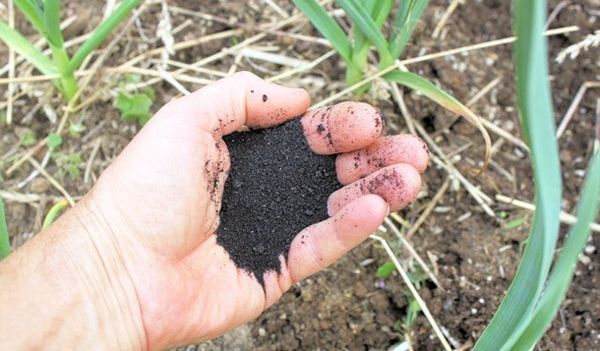Often for cultivation of garlic technology is used, providing planting for the winter. But the harvest does not always meet expectations, due to non-compliance with the schedule of bait. Although culture is considered unpretentious, it requires some attention, especially in matters of fertilizer at the beginning of the season, in anticipation of a period of increased growth. You need to know how to feed the vegetable in the spring, planted before winter.
In addition to chemistry, you can fertilize winter garlic with folk remedies - yeast, chicken droppings, and so on. Spring and winter garlic need different feedings in the open field. Also, for shoots in May and April, care must be taken properly.
Table of contents
Do I need additional dressing for garlic planted before winter?
Garlic upon waking needs a good stimulatorthat allows young shoots to grow stronger and resist diseases and pests. The vegetative period on the nutrient soil, enriched with trace elements useful for the plant, flows faster, which ensures a good harvest.
In the devastated area to collect high-quality root vegetables will not work if you do not water the dressings and fertilize properly. This means that, at best, it will be possible to dig small heads with fine teeth out of the ground. In addition to underdeveloped sizes, the fruits have a poor quality of taste.
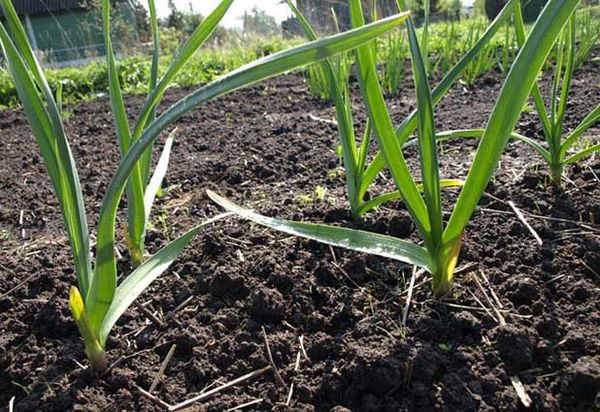
Spring bait is characterized by the activation of plant growth, therefore it is appropriate to use nitrogen fertilizers. Also for the vegetative process, phosphorus and potash feeds are necessary. The introduction of organic or mineral substances strengthens the immunity of garlic to various diseases, in particular fungal.
Diseases and pests affect, above all, weak shoots, so you should not ignore the schedule of processing beds.
With all the utility of fertilizers, do not abuse them. An excess of nutrients provokes the growth of foliage, while the heads are small in size with low taste.
What can feed in the spring
In addition to the planned introduction of fertilizers for growing garlic, apply top dressing. That it is necessary prompts the plant itself.
Young shoots may turn yellow or become lethargic. It is necessary to carefully study the symptoms, because the signs of a lack of trace elements are sometimes similar to nematode and other diseases.
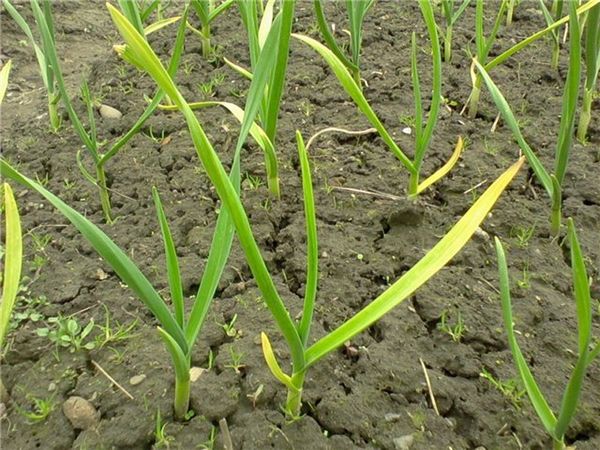
In the spring, gardeners feed garlic thrice. The first procedure is carried out immediately after the snow.At this time, the plant is deficient in minerals necessary for the growing season. Enter the second feed should be no earlier than 2 weeks.
The exact timing and composition of the nutrient mixture are determined depending on the degree of formation of the plant and the characteristic features.
- Beds with dried plants are fertilized ammonium nitrate.
- When bleaching feathers are used potash bait. Before irrigation, you can sprinkle the soil with wood ash.
- Greens may turn yellow due to acidification of the soil. In such cases, before planting the soil is enriched. dolomite flour or ground limestone.
- Slow growth of greenery indicates nutritional deficiencies. Solutions are used as top-dressing: on the basis of urea (1 tbsp. Per bucket of water), mullein (1 cup per 10 liters of water) or bird droppings (1 tbsp. Per bucket of water).
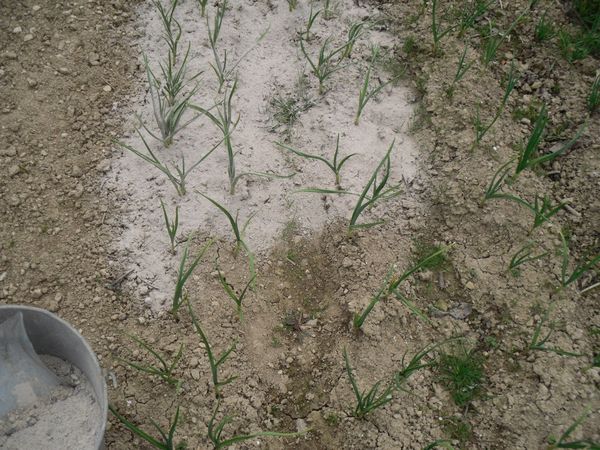
When to fertilize for a good harvest
Important points when growing winter varieties of garlic is soil fertilizer before planting. Spring work on the beds depends on the quality of the preparatory work.
- As soon as the snow comes down, you can plan the first bait. This period occurs in each region at different times, so you need to focus on the well-established positive daily temperature.
- The second stage of soil enrichment with useful substances is carried out two weeks after the first feeding. During ripening, the root crop pulls all nutrients out of the ground, so you should not shift the schedule of fertilizer introduction.
- The third bait (mid-end of June) falls on the period of the formation of the head, which is important for obtaining a good harvest.
- Additional bait introduced only in the presence on the plant signs of a deficiency of trace elements.
What to feed in the open field
Before planting garlic (for a week or two) in the fall, the soil is pre-enriched with a nutrient mixture, which consists of organic or mineral fertilizers.
Organic fertilizers and folk remedies
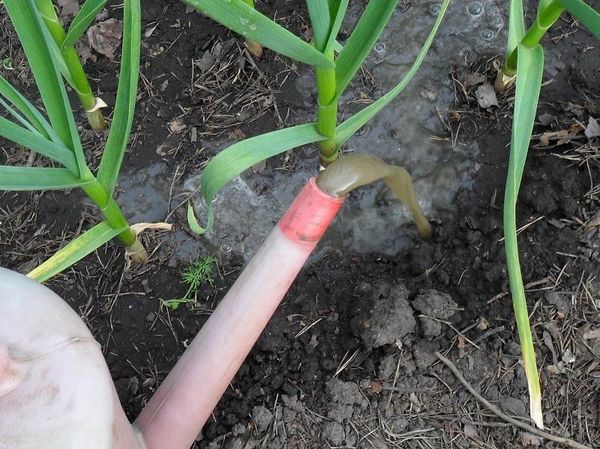
The plant responds most favorably to organic supplements, due to the large amount of humus in the soil and its rich composition. Often, on unexploded soils, one, but full-fledged fertilizer in the fall is enough to provide the crop during the growing season with all the necessary microelements.
One of the popular dressings is considered manure. It is scattered on the beds and carefully dug up. Some gardeners increase fertility with fresh manure, but experts advise against this method. They are also wary of using large amounts of bird droppings; this can simply burn the shoots.
With the onset of spring, efforts should be made to stimulate the growth of culture. For this purpose, a solution is prepared from 7 parts of water and 1 part of mullein. The resulting composition is watered the beds, trying not to affect the penetrated greens.
It will be appropriate to use to enrich the soil. compost. Any, but garlic responds well to food waste fertilizer.
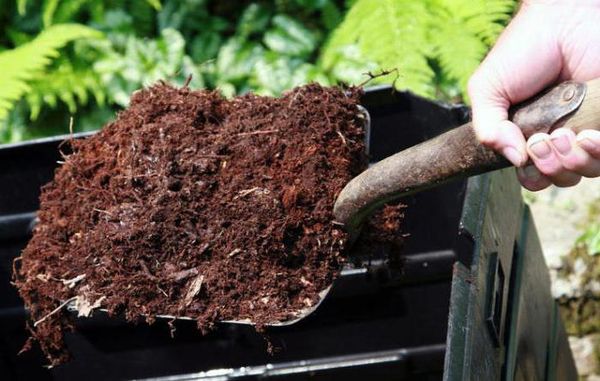
Among other time-tested foods:
- wood ash (sprinkled between the beds or watered with a solution based on water 10 liters and 200 grams of ash.);
- salt (pour a solution prepared from water of 10 liters and 3 tablespoons of salt);
- ammonia (spray plants with a composition based on 25 ml of ammonia and a bucket of water).
Mineral
Mineral based feeds are used alone and in combination with organic.
To fill the balance of nutritional components of one organic is not always possible. Moreover, there is another factor affecting the yield - the climatic features of the region.
Consumption rates depend on the degree of fertility of the soiltherefore, in each individual case, it is necessary to make calculations individually.
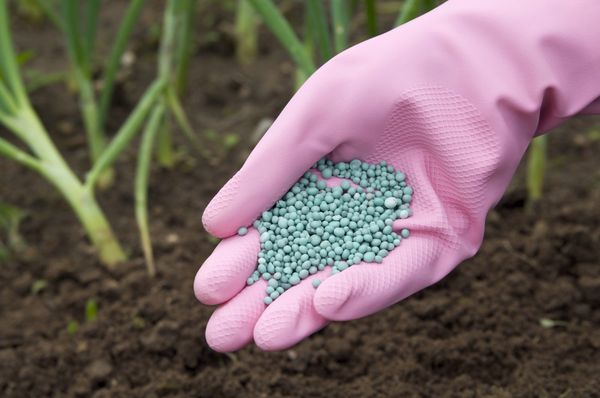
The greatest super popular such mineral dressings:
- carbamide (1 tbsp. per 10 liters of water);
- nitroammophoska (60 g. per 10 liters of water);
- superphosphate (50-60 gr. per bucket of water);
- urea (1 tbsp. per bucket of water);
- nitrophoska (2 tbsp. L on a bucket of water).
Some components appropriate to combine for more efficient means. For example, nitrogen introduced into the soil along with phosphorus (proportions 1: 1.5), promotes the development of greenery, the accumulation of nutrients in the head.
After watering or rain, it is appropriate to sprinkle the beds with a dry mixture, which includes: nitrogen, phosphorus, potassium (proportions 8:15:35).
When determining the amount and composition of fertilizers, important factors should be taken into account:
- the degree of soil fertility, its acidity;
- climate (precipitation, probability of spring frosts);
- illumination area;
- what crops were grown to garlic (the advantage should be given to such predecessors as zucchini, cereals, squash);
- peculiarities of the cultivar (maturation period, preferable conditions for vegetation).
Garlic Feed Scheme
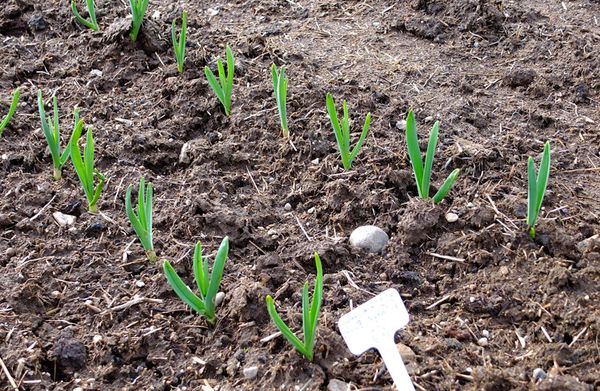
Garlic planted under the winter in spring gives the first shoots. To the vegetative process in the summer flowed without disturbances, it is recommended to process and introduce dressing 3 times. The schedule is based on the following rules.
- Excessive moisture for early culture is considered dangerous, so you need to enter the first supplements in combination with the irrigation procedure. Urea or carbamide is ideal for activating growth and development of shoots. In order to prepare the solution, it is enough to dilute a tablespoon of fertilizer into 10 liters of water.
- The second time to feed the plants 2 weeks after the first procedure. The working solution is water (9 l) and 2 partial spoons of nitrophosphate or nitroammofoski. The rate of fertilizer beds is 4 liters per 1 m2.
- The third dressing is aimed at stimulating the growth of the heads, so it is introduced during the formation of root crops - mid-late June. Superphosphate is used as food (2 tablespoons of the product are used for 10 liters of water). The consumption rate is 4-5 liters per 1 m2.
This method refers to foliar feedings, therefore during the preparation of the agent from mineral components, it should be taken into account that the consumption rate should be reduced by half. Spraying is often combined with regular watering of the beds.
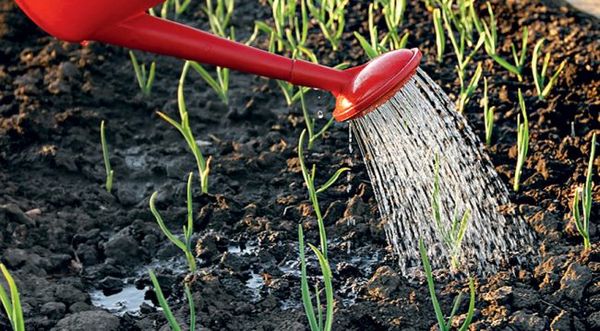
It is worth remembering that the rate of fluid for one bush should not change due to the use of a special solution.
What fertilizers should not be used to process
Enriching the soil for better maturation of plants does not mean to use everything. Each crop responds better to a particular type of fertilizer.
So garlic is well perceived organic, but at the same time to cope with fresh manure will be extremely difficult. Therefore, for fertilizers apply rotted mass.
Experienced gardeners recommend necessarily combine organic nutrition with minerals. In the opposite case, planting material will rot from overabundance of natural humus still in the ground, or the harvest will not differ with a long shelf life.
Compliance with the mode of bait and consumption rates ensures large root crops. A grown crop throughout the cold season will complement its flavor and taste of different dishes, and fight against pathogenic bacteria.
